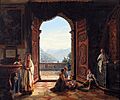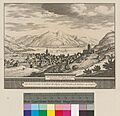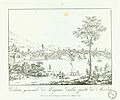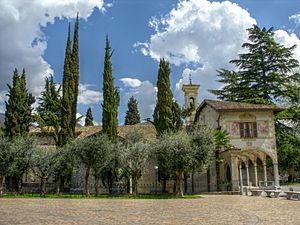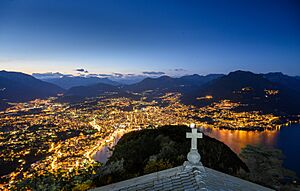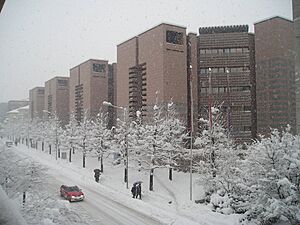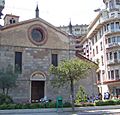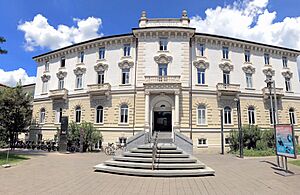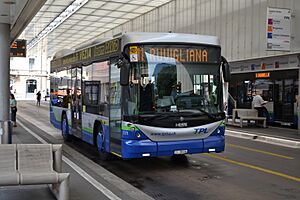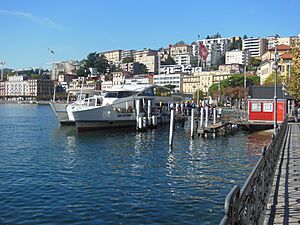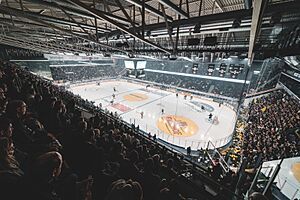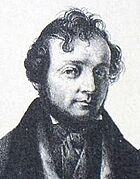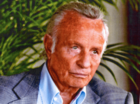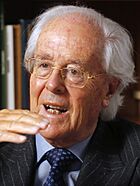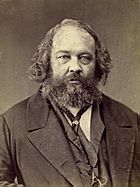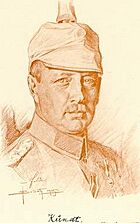Lugano facts for kids
Quick facts for kids
Lugano
Lügán (Lombard) |
||
|---|---|---|
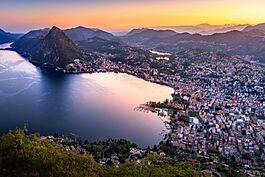
The bay of Lugano at sunset
|
||
|
||
| Country | Switzerland | |
| Canton | Ticino | |
| District | Lugano | |
| Area | ||
| • Total | 75.93 km2 (29.32 sq mi) | |
| Elevation
(Lake shore, Centro)
|
273 m (896 ft) | |
| Postal code |
from 6900 to 6917, 6932, 6951, 6959, from 6962 to 6968, from 6974 to 6979
|
|
| Localities | Barbengo, Besso, Brè-Aldesago, Breganzona, Cadro, Carabbia, Carona, Castagnola-Cassarate, Cureggia, Davesco-Soragno, Gandria, Loreto, Lugano Centro, Molino Nuovo, Pambio Noranco, Pazzallo, Pregassona, Sonvico, Val Colla, Viganello, Villa Luganese | |
| Surrounded by | Arogno, Bioggio, Brusimpiano (Italy), Campione d'Italia (Italy), Canobbio, Capriasca, Collina d'Oro, Grancia, Alta Valle Intelvi (Italy), Massagno, Melide, Morcote, Muzzano, Paradiso, Ponte Capriasca, Porza, Savosa, Sorengo, Valsolda (Italy), Vezia, Vico Morcote | |
Lugano is a large city and municipality in the Ticino canton of Switzerland. It is the biggest city in Ticino and the largest Italian-speaking city in southern Switzerland. Lugano has a population of over 67,000 people and is the ninth largest city in Switzerland.
The city is located on Lake Lugano, where the lake is widest. It shares the entire bay of Lugano with the nearby town of Paradiso. The municipality of Lugano covers a much larger area, including many small villages around the lake. The area is surrounded by the Lugano Prealps, which are mountains that cover most of the southern part of Ticino. Both the western and eastern parts of Lugano share a border with Italy.
Lugano was first mentioned as a market town in 984. It was often fought over by rulers from Como and Milan. In 1513, it became part of the Old Swiss Confederation. The political municipality of Lugano was created in 1803. Since 1882, Lugano has been an important stop on the international Gotthard Railway. This railway helped a lot with the growth of tourism and other services, which are still very important to the city's economy today.
In 1956, Lugano hosted the very first Eurovision Song Contest.
Contents
- Understanding Lugano's Name and Symbols
- Exploring Lugano's Past
- Ancient Times: Pre-history of Lugano
- How Lugano Was Founded
- Lugano in the Renaissance Era
- Lugano Joins the Old Swiss Confederacy
- Lugano During the Enlightenment Period
- Lugano's Role as a Canton
- Lugano in the Early 1800s
- Modernizing Lugano: A City's Transformation
- Lugano After World War II
- Lugano's Replica in Israel
- Lugano's Location and Weather
- People and Population in Lugano
- Top Tourist Spots in Lugano
- Learning and Research in Lugano
- Getting Around Lugano
- Lugano's Culture and Arts
- Sports in Lugano
- Famous People from Lugano
- See also
Understanding Lugano's Name and Symbols
The name "Lugano" was first written down in 804 AD as Luanasco. Later, in 874, it was called Luano, and from 1189, it became Lugano. The local Lombard language version of the name is Lugan.
Historians are not sure where the name comes from. Some ideas include that it comes from the Latin word lucus, meaning "grove" (a small group of trees). Another idea is that it comes from a Latin word meaning "lake-dweller" (someone who lives by a lake). It might even come from the name of a god called Lugus.
Exploring Lugano's Past
Ancient Times: Pre-history of Lugano
People have lived along the shores of Lake Lugano since the Stone Age. Tools and grinding stones from that time have been found within the city limits. Items from the Copper Age and Iron Age have also been discovered around Lugano.
There are also ancient Etruscan monuments in areas like Davesco-Soragno and Viganello, dating back to 5th to 2nd centuries BC. Graves with jewelry and household items, along with Celtic money, show that people lived here long ago.
The Roman Empire settled the area around Lake Lugano by the 1st century BC. While there are fewer Roman traces directly in Lugano, inscriptions, graves, and coins suggest Romans lived here.
How Lugano Was Founded
The first written mention of Lugano dates back to 724. It was in documents where the Longobard king Liutprand gave some land in Lugano to a church in Como. Later documents from 804 and 844 mention Lake Lugano. In 984, Lugano was officially called a market town.
During the 14th and 15th centuries, Lugano was often caught in fights between Como and Milan. After being ruled by the Rusca family for a long time, Lugano gained freedom from Como in 1335. Around this time, the town and its surrounding valley became stronger together. By 1405–06, documents show that Lugano had its own governing body, separate from Como. This new community included several nearby parishes. In 1416, the Duke of Milan, Filippo Maria Visconti, took over the Lugano region and made it his territory. A year later, Lugano's freedoms were written down in laws similar to those of Como, giving the town full independence.
Lugano in the Renaissance Era
-
Fresco by Bernardino Luini, 1529
Between 1433 and 1438, the Duke of Milan ruled Lugano as a feudal lord. He gave the Rusca family ownership of Locarno instead. After his rule, there were many rebellions and riots in Lugano. These conflicts continued until the French invasion in 1499.
Lugano Joins the Old Swiss Confederacy
Lugano was constantly fought over by the rulers of Como and Milan. Powerful families like the Visconti of Milan and the Rusca of Como wanted control. Finally, in 1513, Lugano became part of Switzerland.
An important family during this time was the von Beroldingen family from Uri. Members of this family served as chancellors (important officials) in Lugano from 1576 to 1798. Karl Konrad von Beroldingen (1624-1706) was a key member. He was Lugano's chancellor and a general captain. He also worked for Spain and was given the title of Baron in 1691. He ordered the building of Palazzo Beroldingen and Villa Favorita in Castagnola.
Lugano During the Enlightenment Period
In 1746, the Agnelli brothers opened the first printing press and bookshop in Lugano. They started a newspaper in 1748, which later became the Gazzetta di Lugano in 1797. This newspaper was widely read in Italy. It supported new ideas and even published a part of the United States Declaration of Independence in 1776.
After the editor, Abbot Gian Battista Agnelli, died in 1788, Abbot Giuseppe Lodovico Maria Vanelli took over. Under him, the newspaper supported revolutionary ideas from France. This caused problems with the Austrian government. The newspaper stopped suddenly in 1799 after anti-French riots in Lugano. The printing house was looted, and Abbot Vanelli was shot.
Swiss control of Lugano ended in 1798 when Napoleon conquered Switzerland. He created the Helvetic Republic, and Lugano became its capital.
Lugano's Role as a Canton
The Canton of Lugano brought together several former regions like Lugano, Mendrisio, Locarno, and Valmaggia. However, Lugano's power was very limited because Napoleon wanted to centralize power in Switzerland. The canton was led by five members who appointed a "national prefect."
The canton was divided between "patriots" who supported the Cisalpine Republic and traditional "aristocrats." In 1799, riots broke out in Lugano, and the prefect fled. A temporary government that supported the Habsburgs took over. But French control was restored in 1800. Unhappiness continued, and in 1802, a revolt declared Lugano's independence from the French-controlled republic.
In 1803, the Act of Mediation finally ended the political unrest. The Canton of Lugano merged with Bellinzona to create the Canton of Ticino, which is still in place today.
Lugano in the Early 1800s
After 1803, the political municipality of Lugano was formed. One of its first jobs was to decide how property and power would be shared between the old local community (patriziato) and the new municipality. Agreements in 1804 and 1810 started this process. Later in the 19th century, the municipality gained more property and rights.
Francesco Capra, who was a prefect during the Helvetic Republic, became Lugano's first mayor from 1803 to 1813. The cantonal constitution of 1814 made Lugano, Bellinzona, and Locarno the capitals of Ticino. They took turns being the capital every six years. Lugano was the capital in 1827–33, 1845–51, and 1863–69.
In the 19th century, the city government was mostly controlled by the Liberal Party. By 1900, Liberals held more than half of the seats on the city council. The rest were held by Conservatives or Socialists.
The city government initially had eleven members. This number was reduced to five in 1908 and increased to seven in 2004. For most of the 20th century, the Liberals had the most power. Other positions were held by Conservatives, Socialists, and the Ticino League.
Around 1830, new government buildings started to appear in Lugano. The town also began to grow into the surrounding hills. In 1843–44, the city hall was built. It housed the cantonal government for some years and has been the city government's home since 1890. Roads connecting Lugano to other towns were built in the early 19th century. In 1848, the first steamboat started operating on Lake Lugano, with regular service by 1856.
Modernizing Lugano: A City's Transformation
The building of the Melide causeway in 1844–47 helped the railway line between Chiasso, Bellinzona, Lugano, and Gotthard grow. This growth was boosted even more in 1882 when the Gotthard railway line was finished. The railway station was built in Lugano between 1874–77. This made Lugano a key link between northern Italy and central Europe. It led to a big increase in tourism and service industries.
From the mid-19th century to 1970, Lugano's population grew steadily. Between 1880 and 1910, the population more than doubled. This was partly because many foreigners and people from other parts of Switzerland moved to Lugano. In the last 30 years of the 20th century, the population dropped a little. This happened even after the towns of Castagnola and Brè-Aldesago joined Lugano in 1972. It showed a trend of people moving to the suburbs.
However, in 2004, several more municipalities joined Lugano. These included Breganzona, Cureggia, Davesco-Soragno, Gandria, Pambio-Noranco, Pazzallo, Pregassona, and Viganello. In 2008, Barbengo, Carabbia, and Villa Luganese also joined. Then, in 2013, Bogno, Cadro, Carona, Certara, Cimadera, Sonvico, and Val Colla became part of Lugano. These mergers caused the population to double to over 52,000 by 2006. More than a third of these new residents were foreigners.
Lugano After World War II
-
Banca del Gottardo designed by Mario Botta in the 1980s
-
Edificio Ransila I designed by Mario Botta
After Second World War, especially in the 1960s and 70s, Lugano's banking industry grew very quickly. A lot of money came from nearby Italy. This made Lugano the third largest financial center in Switzerland, with over 100 banks in the city.
Trade, tourism, and finance are the main parts of Lugano's economy. In 2000, most workers were in the service sector. Many of them traveled from other places, including Italy, to work in Lugano. The city hosted the first Eurovision Song Contest in 1956. The Congress Center was built in 1975, and a new City Hospital in 1978. In 1963, the city bought land for the Lugano-Agno airfield, and regular flights started in 1980. In the early 2000s, big projects began, like the Vedeggio-Cassarate car tunnel. This tunnel connects the A2 motorway to the Cornaredo area. There are also plans for a new cultural center and an exhibition center.
Lugano's Replica in Israel
In June 2011, officials in the Israeli town of Yehud announced a big plan. They would build a replica of Lugano's old town square in the center of their town. This project aimed to boost business and tourism in Yehud. The replica would feature neoclassical columns and covered walkways, just like in Lugano.
Lugano's Location and Weather
Lugano's Landscape and Surroundings
The city of Lugano sits on the edge of Lake Lugano. This lake is located between Lago Maggiore and Lago di Como, south of the Swiss Alps. Lugano is in the heart of the Sottoceneri region, which is the part of Ticino south of the Monte Ceneri Pass.
The city center is right on the lake shore. It is just west of where the Cassarate river flows into the lake. Lugano's waterfront curves around the bay. It lies between two mountains: Monte Brè (925 meters or 3,035 feet) and Monte San Salvatore (912 meters or 2,992 feet).
Because of how the city has grown, including some distant areas while leaving closer ones independent, Lugano's borders are a bit unusual. A large, less populated part of the city is on the east side of Lake Lugano, separated by the lake itself. Also, the town of Paradiso is almost completely surrounded by Lugano and the lake, even though it is its own municipality.
Lugano covers a total area of about 32 square kilometers (12.4 square miles). About 10.1% of this land is used for farming. Forests cover 21% of the area. Buildings and roads make up 14% of the land. A very small part (0.1%) is rivers or lakes. The remaining 0.4% is unproductive land.
Most of the water in the municipality is in lakes.
Lugano's Climate and Weather
Lugano is one of the warmest places in Switzerland. It has a humid subtropical climate, which means it has mild winters and warm, humid summers. The average temperature in the warmest month is around 22 °C (71.6 °F).
Lugano gets rain or snow on about 98 days each year. On average, it receives 1559 mm (61.4 inches) of precipitation. May is the wettest month, with about 196 mm (7.7 inches) of rain. February is the driest month, with only about 52 mm (2 inches) of precipitation over 4.6 days.
Because it is on a plain in southern Switzerland and protected by the Alps and lakes, Lugano's climate is very mild. It is typical of the Italian Lakes region. It gets plenty of rain, but temperatures do not change too much. Lugano is also one of the sunniest cities in Switzerland.
It usually snows every winter, but heavy snowfalls are not very common. The highest temperature ever recorded in Lugano was 38.0 °C (100.4 °F) in July 1945. The lowest was -20.4 °C (-4.7 °F) in February 1929.
People and Population in Lugano
Lugano's population has grown a lot due to mergers with nearby towns. Since 2004, when several municipalities joined, and more in 2008 and 2013, Lugano has become the largest city in its canton. As of 2015, about 38.1% of the people living in Lugano are not Swiss citizens. Many of them (23.2%) were born in Italy.
The city's economy provides about 38,000 jobs. More than a third of these jobs are filled by people who travel from other countries, especially Italy, to work in Lugano. Business, tourism, and finance are the main parts of the local economy. Lugano is Switzerland's third largest banking center, after Zurich and Geneva. The people in Lugano mostly speak Italian and are mainly Catholic. Lugano is the largest city outside Italy where Italian is the official language.
Between 1997 and 2007, Lugano's population grew by 6.9%. In 2000, most people (80.3%) spoke Italian. German was the second most common language (7.1%), followed by Serbo-Croatian (2.7%).
In 2008, about 47.1% of the population was male and 52.9% was female. The population included Swiss men (28.1%), non-Swiss men (19.0%), Swiss women (35.3%), and non-Swiss women (17.7%).
The age breakdown in Lugano in 2009 showed that 8.5% of the population was under 10 years old. Teenagers (10-19 years old) made up 9.1%. Adults aged 20-59 made up about 65.4% of the population. People over 60 years old made up about 27% of the population.
In 2000, there were 23,168 private households in Lugano, with an average of 2 people per household. About 19.1% of households owned their homes. Most apartments were 3-room apartments. About 81.7% of apartments were lived in permanently.
Historical Population Growth
The population of the original town of Lugano (before the big mergers after 1972) has changed over time as shown in this chart:

Religious Life in Lugano
According to the 2000 census, most people in Lugano (67.9%) were Catholic. About 5.7% belonged to the Swiss Reformed Church. A significant number of people (17.75%) belonged to other churches not listed. About 8.64% of the population did not answer the question about their religion.
Lugano's Economy and Jobs
In 2007, Lugano's unemployment rate was 5.59%. In 2005, a small number of people (77) worked in farming. About 3,520 people worked in manufacturing and industry. The largest number of people, 33,601, worked in the service sector.
Lugano is a major economic hub in the region. Many workers (28,174) travel into the city for work, while fewer (3,994) leave Lugano for jobs elsewhere. About 12.4% of the workers coming into Lugano are from outside Switzerland. In 2000, 15.2% of the working population used public transport to get to work, and 44.6% used a private car.
In 2009, Lugano had 43 hotels with a total of 1,584 rooms and 2,889 beds for tourists.
Top Tourist Spots in Lugano
Lugano is a very popular place for tourists in Switzerland. The city has many old buildings and museums. The area around Lugano also offers beautiful natural sights.
Both Lake Lugano and the mountains around it provide many outdoor activities. The region near Lugano has over 300 kilometers (186 miles) of mountain biking trails. This is the largest network of trails in Switzerland.
Important Historic Sites in Lugano
Lugano has 17 sites that are considered important national heritage sites in Switzerland. The city of Lugano itself, along with the areas of Barbengo, Brè, Gandria, and Biogno, are all part of the Swiss Heritage Sites list.
These important sites include two libraries: the Biblioteca Cantonale and the Biblioteca Salita dei Frati. The Swiss National Recording Archives, which keeps sound recordings, is also a national heritage site. There are three important churches: Cathedral of San Lorenzo, Church of Santa Maria degli Angioli, and the Church of San Rocco.
Four museums are also listed: the Museo Cantonale d'Arte, the Museum of Modern Art, the Museo cantonale di storia naturale di Lugano, and the Villa Ciani complex with the Museo civico. In 2015, the two art museums merged to form MASI Lugano. The cemetery at via Trevano is also a heritage site. The Italian-language broadcast facility of Radiotelevisione svizzera di lingua italiana (RTSI) is another important site. Other sites are historic houses throughout the town, including the Palazzo civico (City Hall) and Villa Favorita.
Amazing Natural Places to See
A very popular spot in Lugano is Lake Lugano. The lake is about 48.7 square kilometers (18.8 square miles) in size. Most of it (63%) is in Switzerland, and 37% is in Italy. The lake is usually about 1 kilometer (0.6 miles) wide, but at its widest, it is almost 3 kilometers (1.9 miles). The deepest part of the lake is 279 meters (915 feet). The water is generally warm, with summer temperatures from 19.5 °C (67.1 °F) to 24.0 °C (75.2 °F).
Several companies offer boat tours on the lake. A popular trip is by boat to the beautiful village of Gandria, located by the lake. There are also many places to rent boats or find water taxis. You can swim in the lake at any of the about 50 swimming spots along the Swiss shores.
Besides the lake, Lugano is surrounded by mountains. These mountains offer many chances for sports or sightseeing. Two mountains, both with great views of the city and lake, are on either side of the town's waterfront. Monte Brè (933 meters or 3,061 feet) is to the north and is said to be Switzerland's sunniest spot. It also has the old village of Brè. Monte San Salvatore (912 meters or 2,992 feet) is to the south. It has an old church and a museum at its top. You can reach both mountains by funicular railways, which are like small trains that go up steep hills.
A bit further away is Monte Generoso (1704 meters or 5,591 feet). From its top, you can see Lake Lugano, Lake Como, and Lake Maggiore. You can also see the Alps and the Lombardy Plains. On a clear day, you might even see the city of Milan. You can get to the summit by taking a boat or train to Capolago, then changing to a rack railway train.
Places of Worship in Lugano
- St. Lawrence Cathedral (built between the 9th and 15th centuries)
- St. Mary of the Angels Church (16th century) with a famous fresco of Christ's Passion by Bernardino Luini
- San Rocco Church
Important Buildings in Lugano
- Park and Villa Ciani
- Palazzo Civico (City Hall)
- Villa Favorita
- Palazzo Albertolli
Museums to Visit in Lugano
- MASI Lugano (or Swiss–Italian Art Museum), located at three sites:
- Lugano Arte e Cultura (LAC), a cultural center for visual arts, music, and performing arts
- Palazzo Reali
- Giancarlo and Danna Olgiati Collection
- Museo delle Culture (Museum of Cultures)
- Foundation Aligi Sassu and Helenita Olivares
- Historical Museum
- Cantonal Museum of Natural History of Lugano
- Swiss Customs Museum
- Wilhelm Schmid Museum
- Hermann Hesse Museum
- Swiss National Sound Archives
Learning and Research in Lugano
In Lugano, about 63.7% of adults (aged 25–64) have completed higher education. This includes university or a University of Applied Sciences.
In 2009, Lugano had a total of 7,931 students. The Ticino education system offers up to three years of optional kindergarten. In Lugano, 1,356 children were in kindergarten. Primary school lasts five years. There were 2,280 students in regular primary schools and 129 in special schools.
For middle school, students either go to a two-year middle school followed by a two-year pre-apprenticeship, or a four-year program to prepare for university. There were 1,932 students in the two-year middle school and 884 in the four-year program.
High school (upper secondary) prepares students for trades or university. Vocational students can attend school while working or attend school first, then do an internship. There were 492 full-time vocational students and 722 part-time. The professional program lasts three years and prepares students for jobs in fields like engineering or nursing.
As of 2000, 3,537 students came to Lugano from other towns for school. Lugano has two libraries: the Biblioteca universitaria di Lugano and the Biblioteca cantonale Lugano. In 2008, these libraries had over 448,000 books and other media.
The main campus of the Università della Svizzera Italiana (USI) is in Lugano. It includes five of its six faculties. The main building, built in 1909, was originally Lugano's hospital. Since 1996, it has been home to the university. New buildings have been added, including the "East Campus" across the river, which opened in 2021. This new campus houses both USI and the University of Applied Sciences of Southern Switzerland (SUPSI).
Some of the universities and colleges in Lugano include:
- Università della Svizzera Italiana (USI): This university has faculties for Informatics, Economics, Communication, Culture and Society, Biomedical Sciences, Theology, and the Academy of Architecture (in Mendrisio).
- Swiss National Supercomputing Centre: A research center focused on high-performance computing.
- Dalle Molle Institute for Artificial Intelligence (IDSIA): A research institute for artificial intelligence, connected to both USI and SUPSI.
- Franklin University Switzerland: An American and Swiss accredited liberal arts college.
- The American School In Switzerland: An international high school.
- SUPSI: University of Applied Sciences and Arts of Southern Switzerland.
Getting Around Lugano
Air Travel to Lugano
Lugano is served by Lugano Airport, located in the nearby town of Agno. Currently, only Silver Air operates flights to Lugano Airport. While there are limited flights directly to Lugano, Milan's airports are not far away. They offer many more flight options to places around the world. Milan Malpensa Airport is connected to Lugano by a direct train that takes about 1 hour and 45 minutes. It's also about an hour's drive (80 km or 50 miles) by road.
Train Travel in Lugano
Lugano's railway station is on the important Gotthard railway line. This line connects northern Switzerland with Ticino and Italy. Since the opening of the Gotthard Base Tunnel in 2016 and the Ceneri Base Tunnel in 2020, train connections to cities like Zürich, Luzern, and Basel have become much faster.
Long-distance trains from the Swiss Federal Railways (SBB CFF FFS) and international trains from Trenitalia connect Lugano to northern Switzerland and Italy. These trains are called InterCity and EuroCity. There are hourly trains to Zurich and trains every two hours to Basel and Milan. One train per day goes to Bologna, Genoa, and Venice. All these trains use the new base tunnels. From April to mid-October, the tourist-focused Gotthard Panorama Express connects Lugano with Lucerne once a day. It travels over the old Gotthard route by train and then by boat on Lake Lucerne.
Lugano also has regional trains from the Treni Regionali Ticino Lombardia (TILO) network. These trains run in Ticino and northern Italy. Line RE80 offers a fast service every half hour north to Locarno and south to Mendrisio and Chiasso. Some southbound trains continue to Milan. Line S10 provides a local service every half hour north to Bellinzona and Biasca, and south to Mendrisio and Chiasso. Some southbound trains continue to Como. Line S50 runs hourly to Milan Malpensa Airport. Line S90 provides a half-hourly service north to Giubiasco and an hourly service south to Mendrisio, using the old high-level Ceneri route.
Additionally, the Lugano-Ponte Tresa Railway (FLP) runs every 15 minutes to Agno, Lugano Airport, and Ponte Tresa. This service is called line S60 and has its own station next to the main railway station.
Lugano also has three funicular railways. The Funicolare Città–Stazione connects the railway station to the lower city center near the lake. The Funicolare Monte Brè and the Funicolare Monte San Salvatore go up nearby hills, offering great views. A fourth funicular, the Funicolare degli Angioli, exists but has not operated since 1986.
Roads and Buses in Lugano
Lugano is located along the A2 motorway. This motorway is part of the European route E35, which stretches over 1600 kilometers (994 miles) between Amsterdam and Rome. To the north, the A2 crosses the Ceneri and Gotthard passes, connecting Lugano to northern Switzerland and the German motorway network. To the south, it crosses into Italy at Chiasso, linking to the Italian motorway network. The motorway runs west and south of the city, using many tunnels because of the mountains.
The Trasporti Pubblici Luganesi (TPL) operates frequent city buses throughout Lugano and its nearby areas. The Autolinee Regionali Luganesi (ARL) runs buses connecting Lugano with areas like Davesco, Sonvico, Canobbio, Lamone, and Tesserete. The Società Navigazione del Lago di Lugano (SNL) runs buses to lakeside areas like Gandria and Campione d'Italia, in addition to its boat services. TPL, ARL, and SNL buses all operate from the Lugano Centro bus station.
Longer-distance buses and some local buses are run by PostBus Switzerland. Their Palm Express service connects Lugano railway station to St. Moritz. Other PostBus services operate from an underground bus station in central Lugano. ASF Autolinee, an Italian bus company, runs an international bus route from Lugano to Menaggio, on Lake Como.
Boat Services on Lake Lugano
Boats from the Società Navigazione del Lago di Lugano (SNL) offer services on Lake Lugano. While these are mainly for tourists, they also connect Lugano with other communities around the lake. Several of the boat stops are in less populated parts of the municipality on the east side of the lake, which do not have road access.
Lugano's Culture and Arts
Lugano is home to the Swiss National Sound Archives. This institution is responsible for keeping and protecting Switzerland's sound heritage.
The Palazzo dei Congressi is Lugano's main center for performing arts. It is the primary venue for the Orchestra della Svizzera Italiana.
The Lugano Festival takes place in April and May. It is followed by the "Progetto Martha Argerich" in June. Estival Jazz happens in July. Between July and August, there is the LongLake Festival. This is one of the biggest outdoor events in Switzerland. For a month, the LongLake Festival offers over 300 events in downtown Lugano.
The Blues-to-Bop Festival takes place in late August and early September. It fills the town with activity as thousands of people gather in the streets and squares for free outdoor concerts.
In 1956, the Teatro Kursaal in Lugano hosted the very first Eurovision Song Contest.
The MASI (Museo d'Arte della Svizzera italiana) has two main goals. It aims to preserve and study the museum's art collection, which mainly includes works from the 19th and 20th centuries. It also plans and presents temporary exhibitions. The museum focuses on art from the cantons of Ticino and Graubünden. It regularly features artists from the region. Lugano Arte e Cultura (LAC) is a cultural center for music, visual arts, and performance arts. It opened in 2015.
The area of Brè-Aldesago offers charming spots with its unique stone buildings. The cobblestone streets of the town provide an interesting art path for art lovers. This path is special because it features works by both national and international artists, combining art with the natural environment.
Sports in Lugano
Hockey Club Lugano (HCL) plays in the National League (NL), which is the top ice hockey league in Switzerland. They play at the Resega arena. The team has won seven national titles. They have also reached the final round of the European Cup twice and the top four final in the Euroleague once. In 1991, Lugano made it to the final of the Spengler Cup. They also finished third twice in the IIHF Continental Cup Superfinal.
FC Lugano plays in the Swiss Super League, Switzerland's top football league. They play at the Stadio Cornaredo. The team won the Swiss title in 1938, 1941, and 1949. They also won the Swiss Cup in 1931, 1968, and 1993. The Stadio Cornaredo is the largest stadium in Lugano. It can hold 15,000 people. It hosted the Italy-Belgium match during the 1954 FIFA World Cup. Some say Lugano is the smallest city ever to host a World Cup match. Around the football field, there is a gravel track used for athletic events. Outside of official matches, joggers can use it for free. Next to the stadium are three smaller training fields. There are also two artificial grass fields: one for field hockey and one for football. A skate park is also located next to the stadium.
BC Lugano Tigers (formerly Basket Club Lugano) plays in the Swiss National League A (LNA). They play at the Elvetico gym. They won the Swiss Cup in 2011 and have been Swiss LNA Champions in 2000, 2001, 2006, and 2010.
Lugano hosts the 20-kilometer (12.4-mile) racewalk Gran Premio Città di Lugano Memorial Albisetti every year. It also hosts the Ladies Open Lugano, an international WTA tennis tournament. The city hosted the UCI Road World Championships in 1953 and 1996. It also hosted the 18th Chess Olympiad.
Lugano has a strong history in Water polo. The Società Nuoto Lugano team has won the Swiss Championship a total of 17 times.
Famous People from Lugano
People Born in Lugano
- Giovanni Battista Trevano (c.1560–1644), an Italian-speaking architect who worked as a royal architect in Poland.
- Francesco Contin (1585–1654), a Swiss-Italian sculptor and architect.
- Giovanni Battista Discepoli (1590–1660), a Swiss-Italian painter from the Baroque period.
- Gasparo Molo (15??-16??), a goldsmith.
- Karl Konrad von Beroldingen (1624-1706), Lugano's chancellor and general captain.
- Carlo Giuseppe Plura (1663–1737), a Swiss-Italian stucco artist and sculptor.
- Giovanni Maria Fontana (c.1670–after 1712), an Italian-Swiss architect who worked in Russia.
- Giacomo Zanetti (c.1696–1735), an Italian master builder and architect.
- Domenico Reina (1796–1843), a Swiss opera singer and composer.
- Carlo Bossoli (1815–1884), a Swiss-born Italian painter and lithographer.
- Domenico Giambonini (1868–1956), a Swiss sport shooter who won a bronze medal in the 1920 Summer Olympics.
- Leonardo Conti MD (1900–1945), a health leader in Nazi Germany.
- Romano Amerio (1905–1997), a Catholic theologian.
- Niccolò Tucci (1908–1999), a short story writer and novelist.
- Lauro Amadò (1912–1971), a Swiss football player who played 54 games for the Swiss national team.
- Mario Agliati (1922–2011), a Swiss-Italian journalist, writer, and historian.
- Mario Comensoli (1922–1993), a Swiss realist painter.
- Sergio Mantegazza (born 1927), a Swiss-Italian businessman and owner of Globus, a travel company.
- Duilio Arigoni (1928–2020), a Swiss chemist who studied how natural substances are made.
- Tito Tettamanti (born 1930), a Swiss lawyer, politician, and entrepreneur.
- Giulia Daneo Lorimer (1932–2021), Italian violinist and singer.
- Pietro Balestra (1935–2005), a Swiss economist.
- Franco Ambrosetti (born 1941), a jazz trumpeter and composer.
- Christian Giordano (born 1945), a Swiss anthropologist and sociologist.
- Giorgio Giudici (born 1945), a Swiss architect and politician, Mayor of Lugano from 1984–2013.
- Romolo Nottaris (born 1946), a Swiss rock climber, mountaineer, and documentary filmmaker.
- Chiara Banchini (born 1946), Swiss Baroque violinist.
- Loris Kessel (1950–2010), a Swiss racing driver.
- Georg Heinrich Thyssen-Bornemisza (born 1950), a manager.
- Luca Pianca (born 1958), a Swiss musician who plays the archlute.
- Diego Fasolis (born 1958), a Swiss classical organist and conductor.
- Marco Borradori (1959–2021), a Swiss lawyer and politician, Mayor of Lugano from 2013–2021.
- Mauro Gianetti (born 1964), a Swiss former professional cyclist.
- Gianluca Barilari (born 1964), head coach of the Swiss national basketball team.
- Carlo Bonzanigo (born 1966), an Italian and Swiss car designer.
- Hardy Krüger junior (born 1968), a German actor.
- Antonio Esposito (born 1972), a Swiss-Italian former footballer.
- Christian Rebecchi (born 1980), a Swiss painter and sculptor, part of the NEVERCREW artist duo.
- Joël Camathias (born 1981), a Swiss racing driver.
- Alberto Regazzoni (born 1983), a footballer who played over 440 games.
- Elly Schlein (born 1985), Italian politician.
- Stefano Comini (born 1990), a Swiss racing driver.
- Alex Fontana (born 1992), a Swiss racing driver.
People Who Lived or Died in Lugano
- Mikhail Bakunin (1814–1876), a Russian revolutionary anarchist.
- Enrico Bignami (1844–1921), an Italian merchant and editor of a socialist newspaper.
- Ferdinando Fontana (1850–1919), an Italian journalist, writer, and socialist.
- Hans Kundt (1869–1939), a German military officer who was important in Bolivia.
- Heinrich Thyssen (1875–1947), a German-Hungarian businessman and art collector.
- Hermann Hesse (1877–1962), a famous author and philosopher who won the Nobel Prize in 1946.
- Jurgis Šaulys (1879–1948), a Lithuanian economist, diplomat, and politician.
- Wilhelm Backhaus (1884–1969), a German pianist.
- Alfred Neumann (1895–1952), a German writer.
- Rudolf Caracciola (1901–1959), a German racing driver.
- Gustav Fröhlich (1902–1987), a German actor and film director.
- Ernst Marlier (1875–1948), a German pharmaceutical manufacturer.
- Rainis (1865-1929), a Latvian poet, playwright, and politician.
- Aspazija (1865-1943), a Latvian poet and playwright.
- Mariuccia Medici (1910–2012), an Italian-born Swiss actress.
- Caterina Valente (born 1931), an Italian-French singer, guitarist, dancer, and actress.
- Mina (born 1940), a famous Italian singer.
- Steve Reid (1944–2010), an American jazz drummer.
- Robert Palmer (1949–2003), an English singer-songwriter.
- Behgjet Pacolli (born 1951), former President of Kosovo and a businessman.
- Ivo Pogorelić (born 1958), a Croatian pianist.
- Johann Sebastian Paetsch (born 1964), an American cellist.
- Anna Kravtchenko (born 1976), a Ukrainian classical pianist.
- Alberto Contador (born 1982), a Spanish professional cyclist who won the Tour de France.
- Nicole Cooke MBE (born 1983), a Welsh former professional road bicycle racer and Olympic champion.
See also
 In Spanish: Lugano para niños
In Spanish: Lugano para niños







